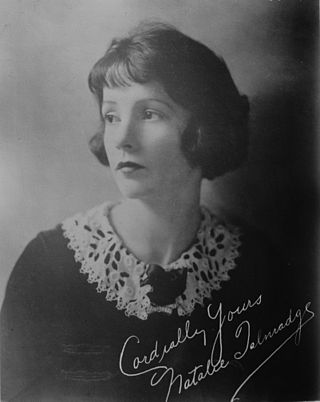
Joseph Frank "Buster" Keaton was an American actor, comedian, and filmmaker. He is best known for his silent film work, in which his trademark was physical comedy accompanied by a stoic, deadpan expression that earned him the nickname "The Great Stone Face". Critic Roger Ebert wrote of Keaton's "extraordinary period from 1920 to 1929" when he "worked without interruption" as having made him "the greatest actor-director in the history of the movies". In 1996, Entertainment Weekly recognized Keaton as the seventh-greatest film director, writing that "More than Chaplin, Keaton understood movies: He knew they consisted of a four-sided frame in which resided a malleable reality off which his persona could bounce. A vaudeville child star, Keaton grew up to be a tinkerer, an athlete, a visual mathematician; his films offer belly laughs of mind-boggling physical invention and a spacey determination that nears philosophical grandeur." In 1999, the American Film Institute ranked him as the 21st-greatest male star of classic Hollywood cinema.
The following is an overview of 1924 in film, including significant events, a list of films released and notable births and deaths.
The following is an overview of 1923 in film, including significant events, a list of films released and notable births and deaths.
The following is an overview of 1922 in film, including significant events, a list of films released and notable births and deaths.
The following is an overview of 1921 in film, including significant events, a list of films released and notable births and deaths.

John Leslie Coogan was an American actor and comedian who began his film career as a child actor in silent films. Coogan's role in Charlie Chaplin's film The Kid (1921) made him one of the first child stars in the history of Hollywood. He later sued his mother and stepfather over his squandered film earnings and provoked California to enact the first known legal protection for the earnings of child performers, the California Child Actor's Bill, widely known as the "Coogan Act". Coogan continued to act throughout his life, later earning renewed fame in middle age portraying Uncle Fester in the 1960s television series The Addams Family.

Limelight is a 1952 American comedy-drama film written, produced, directed by, and starring Charlie Chaplin, based on a novella by Chaplin titled Footlights. The score was composed by Chaplin and arranged by Ray Rasch.

Norma Marie Talmadge was an American actress and film producer of the silent era. A major box-office draw for more than a decade, her career reached a peak in the early 1920s, when she ranked among the most popular idols of the American screen.

The Kid is a 1921 American silent comedy-drama film written, produced, directed by and starring Charlie Chaplin, and features Jackie Coogan as his foundling baby, adopted son and sidekick. This was Chaplin's first full-length film as a director. It was a huge success and was the second-highest-grossing film in 1921. Now considered one of the greatest films of the silent era, in 2011 it was selected for preservation in the United States National Film Registry by the Library of Congress.

The Playhouse is a 1921 American two-reel silent comedy film written by, directed by, and starring "Buster" Keaton. It runs for 22 minutes, and is most famous for an opening sequence where Keaton plays every role.

Natalie Talmadge was an American silent film actress who was the wife of Buster Keaton, and sister of the movie stars Norma and Constance Talmadge. She retired from acting in 1923.

Al St. John was an early American motion-picture comedian. He was a nephew of silent film star Roscoe "Fatty" Arbuckle, with whom he often performed on screen. St. John was employed by Mack Sennett and also worked with many other leading players such as Charlie Chaplin, Buster Keaton and Mabel Normand. His film career successfully transitioned from the silent era into sound, and by the late 1930s and 1940s he was working predominantly in Westerns, often portraying the scruffy comedy-relief character "Fuzzy Q. Jones". Among his notable performances in that role are in the "Billy the Kid" series of films released by the Producers Releasing Corporation from 1940 to 1946 and in that company's "Lone Rider" series from 1941 to 1943.

Margaret Leahy was a British actress. After winning a beauty contest, Leahy went on to make only one film in her very short-lived film career.

Carter DeHaven was an American film and stage actor, film director, and screenwriter.

Spite Marriage is a 1929 American silent comedy film co-directed by Buster Keaton and Edward Sedgwick and starring Keaton and Dorothy Sebastian. It is the second film Keaton made for MGM and his last silent film, although he had wanted it to be a "talkie" or full sound film. While the production has no recorded dialogue, it does feature an accompanying synchronized score and recorded laughter, applause and other sound effects in some scenes. Keaton later wrote gags for some up-and-coming MGM stars like Red Skelton, and from this film recycled many gags, some shot-for-shot, for Skelton's 1943 film I Dood It.
Photoplay Productions is an independent film company, based in the UK, under the direction of Kevin Brownlow and Patrick Stanbury. Is one of the few independent companies to operate in the revival of interest in the lost world of silent cinema and has been recognised as a driving force in the subject.
Beulah Livingstone was a publicist in the theatrical and motion picture industries. In 1926 she was named by the Associated Motion Picture Advertisers as one of the 12 women who had accomplished the most for the motion picture industry; the other 11 women were all actresses or screenwriters.
The International Buster Keaton Society Inc.— a.k.a. "The Damfinos"—is the official educational organization dedicated to comedy film producer-director-writer-actor-stuntman Buster Keaton.

My Boy is a 1921 American silent comedy-drama film directed by Victor Heerman and Albert Austin, and starring child actor Jackie Coogan.












